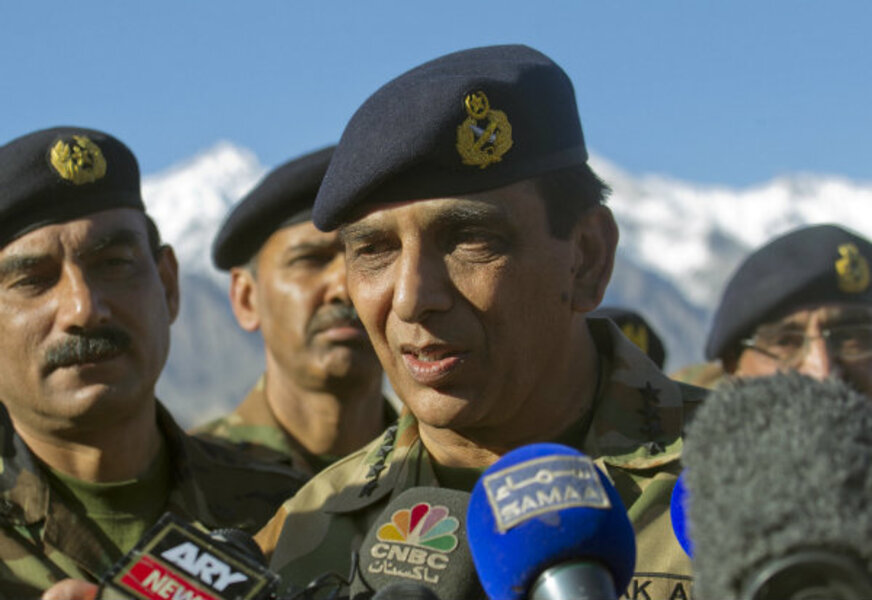How a glacier could thaw dangerous India and Pakistan freeze
Loading...
| Honolulu
Caught up in the dynamics of nuclear brinkmanship, India and Pakistan hold their entire region hostage to clear and present danger. But a recent impromptu meeting between two heads of state and a deadly glacial avalanche could be the start for thawing relations between the nuclear-armed arch rivals.
On April 8, Indian Prime Minister Manmohan Singh and Pakistani President Asif Zardari met in New Delhi, proffering a long-awaited opportunity to pursue stability in South Asia. Both their overtures signal a softening of attitudes. But will the meeting serve as symbolic kow-towing or will the statesmen open up space for future talks?
Since independence from British colonial rule in 1947, protracted territorial and political disputes have led India and Pakistan to engage in three full scale and three quasi-wars. Cross-border skirmishes are common. Indian allegations concerning Pakistan’s involvement in a number of terrorist attacks inside its territory complicate relations further.
The intractable Kashmir conflict, the core of the strained relationship, makes it a veritable nuclear flashpoint. But the contention over Kashmir should not prevent India and Pakistan from solving problems on a host of issues of less strategic concern.
One such issue is the dispute over the Siachen Glacier, a territorial tussle with substantial economic and human costs for the two states. Tragically, on the eve of the meeting between the two heads of state, Siachen experienced a deadly avalanche killing 135 Pakistani soldiers and civilians.
Known as the world’s highest battleground, Siachen is located at an elevation ranging between 11,000 to 22,000 feet. Since April 1984, when India and Pakistan deployed troops in a tit-for-tat competition for territory, both militaries have lost an estimated 5,000 and 3,000 soldiers respectively, primarily due to adverse climate and treacherous terrain.
While an unofficial cease-fire at the Siachen Glacier remains in force since 2003, both India and Pakistan continue an armed standoff in the region. Exclusive territorial claims stem from ambiguities in agreements defining the cease-fire line, or the Line of Control to the northeast of Kashmir following the wars of 1948 and 1971. India has approximately 7,000 troops deployed in the region, and Pakistan about 4,000.
It is estimated that fewer than a thousand lives have been lost in combat during the past 28 years. More men here die due to harsh weather, high altitude illness, and other hazards. On average, one Pakistani soldier is killed every third day in Siachen, with a higher Indian average of one soldier every other day.
Siachen is sometimes regarded as a by-product of the Kashmir conflict. But unlike their hardened positions on Kashmir, both states have demonstrated a willingness to explore a negotiated settlement on the Siachen dispute, with 12 rounds of talks already held between 1985 and 2011. Regrettably, none have reached fruition.
Now in the wake of the avalanche, Pakistan Army Chief General Ashfaq Parvez Kayani is calling for demilitarization, an opportunity that must not be missed by India. The cost of deploying battalions in the region runs in millions of dollars each year for the two impoverished nations.
Yet both states maintain their military status quo to defend a 50-mile long icy wasteland. India and Pakistan have each recognized that defense expenditure in Siachen does not justify its lack of strategic advantage. But they also need to account for the financial, social, and psychological costs for the families of the snow warriors, most of them junior soldiers, in the calculus.
While settling the claims on Siachen may not happen very soon, demilitarization is an actionable option. In 2005, Indian Prime Minister Singh had expressed hope for turning the glacier into a peace mountain. Indian and Pakistani mountaineers and environmentalists have also called for the possibility of converting the region into a civilian zone or peace park.
Such an initiative could potentially transform the battlefield into a jointly managed conservation area serving a threefold purpose: to preserve the environment, to help build peace, and to generate revenue through ecotourism.
Settlement of inter-state territorial disputes present challenges, but the dividends of cooperation for India and Pakistan would be immense, particularly in terms of greater regional and global stability. There is also a strong precedent for joint military disengagement: One took place at the Chumik Glacier in 1989, close to Siachen.
Another hopeful sign is that the two militaries have largely upheld the 2003 cease-fire. Joint aerial and on-site inspections could make demilitarization a viable option especially if facilitated by the UN, sponsor of the 1949 cease-fire agreement.
Unresolved territorial disputes have led India and Pakistan to conventional warfare in the past. But the addition of nuclear weapons in the security landscape makes their standoff more precarious than ever.
Given the implications of their tenuous relationship, it is time for a paradigm shift in strategic thinking in India and Pakistan. And Siachin could help break this deadlock.
Saira Yamin is associate professor at the Asia-Pacific Center for Security Studies in Honolulu. The views expressed in this article are those of the author and do not reflect the official policy or position of APCSS, the US Pacific Command, the US Department of Defense, or the US government.





